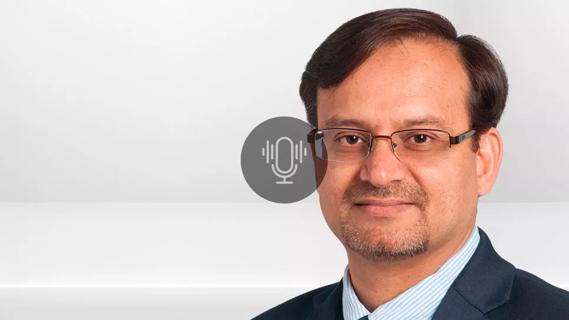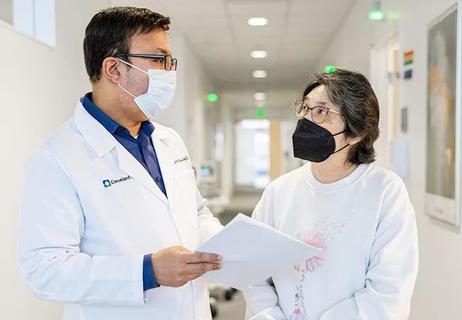In 2007, a 32-year-old woman presented at a large university medical center following a seizure and was diagnosed with anaplastic oligodendroglioma, a relatively uncommon brain tumor.
Cleveland Clinic is a non-profit academic medical center. Advertising on our site helps support our mission. We do not endorse non-Cleveland Clinic products or services. Policy
A case study documents how a team of physicians ultimately used molecular-based planning, nuanced radiation delivery and anti-angiogenic therapy to restore the patient’s speech and mobility after she sought re-treatment at Cleveland Clinic’s Rose Ella Burkhardt Brain Tumor and Neuro-Oncology Center.
At the university medical center where the patient was originally diagnosed, physicians considered the tumor’s molecular characteristics and determined that it would be favorable to treatment with radiation and chemotherapy, a fairly standard regimen at that time. The patient initially responded well.
Three years later, the cancer recurred.
After a biopsy, the patient received additional chemotherapy. A repeat biopsy was taken at a second site and the patient developed wound complications. The tumor progressed and the patient was treated with a variety of chemotherapies during the next four years.
The patient presented at Cleveland Clinic in early-2015 with right hemiparesis and difficulty finding words. She was placed in the care of radiation oncologist Samuel Chao, MD, and Manmeet S. Ahluwalia, MD, Director of the Brain Metastasis Research Program and Section Head of Neuro-Oncology Outcomes. Both physicians specialize in brain tumors and brain metastases at the Burkhardt Center.
“Dr. Ahluwalia and I work closely together,” says Dr. Chao. “We always work as a team to decide and deliver treatment.”
Since the patient had had little success with chemotherapy, the physicians decided instead to repeat a course of radiation and to add the anti-angiogenic drug bevacizumab. Factors contributing to this decision included the time since the patient’s initial radiation and the fact that much of the cancer’s progression had been outside the field of that radiation.
“Based on our preliminary studies, we knew that patients treated with bevacizumab and radiation did better than if they were given bevacizumab alone,” Dr. Chao says. “The latter was especially important in her case, as she was developing symptoms and we wanted to relieve the mass effect quickly.”
A pulsed low-dose-rate technique enabled the physicians to slow the delivery of radiation to their patient. The protocol is regularly used at the Burkhardt Brain Tumor Center when re-treating brain tumors.
“We are doing translational research with Dr. Jennifer Yu and are learning more about dose-rate effects of radiation,” says Dr. Chao.
Jennifer Yu, MD, PhD, is an associate staff member in the Department of Stem Cell Biology and Regenerative Medicine in Cleveland Clinic’s Lerner Research Institute. Her research is focused on the key tumorigenic properties of glioma stem cells which, among other things, are resistant to radiation.
“The pulsed low-dose-rate technique takes advantage of the tumor’s biology, allowing for the tumor to be exposed to radiation as it goes through the most radiation sensitive phase of the cell cycle, allowing potentially more efficacy with the radiation and a better therapeutic ratio,” says Dr. Chao.
The treatment schedule required the patient to remain in Cleveland for six weeks. During that time, both physicians observed that her ability to speak was improving and that she was regaining strength and mobility on her right side.
At a checkup three months after the conclusion of this treatment, Dr. Chao observed a slight decrease in the tumor’s size on MRI.
He says that he continues to examine the patient every two months and that her improvement has sustained. “She continues to spend quality time with her very close family, including her three children,” he says.
If the patient should require additional therapy, “I won’t use more radiation, given the total amount she has received,” Dr. Chao says. However, there are many salvage therapies that could be considered, he says, including immunotherapies currently under investigation at Cleveland Clinic.
Ongoing neuro-oncology research provides the basis for evolving treatment protocols at the Burkhardt Brain Tumor Center. “For instance, our studies of the molecular signature of brain tumors now have an impact on how we treat our patients,” Dr. Chao says. “Rather than classifying patients simply on the basis of how the cells look under the microscope, we now tailor the treatment based on molecular data.”
The medical oncology team at the Burkhardt Brain Tumor Center is conducting trials of several novel agents to treat recurrent brain tumors, and the neurosurgical team is developing several devices to help remove tumors less invasively, and to deliver chemotherapy more effectively and directly to the tumor, he says.
Photo Credit: ©Russell Lee

First-of-its-kind research investigates the viability of standard screening to reduce the burden of late-stage cancer diagnoses

Study demonstrates ability to reduce patients’ reliance on phlebotomies to stabilize hematocrit levels

Findings highlight an association between obesity and an increased incidence of moderate-severe disease

Cleveland Clinic Cancer Institute takes multi-faceted approach to increasing clinical trial access

Key learnings from DESTINY trials

Gene editing technology offers promise for treating multiple myeloma and other hematologic malignancies, as well as solid tumors

Study of 401,576 patients reveals differences in cancer burdens as well as overall survival

Enfortumab plus pembrolizumab reduced risk of death by 53% compared with platinum-based chemotherapy